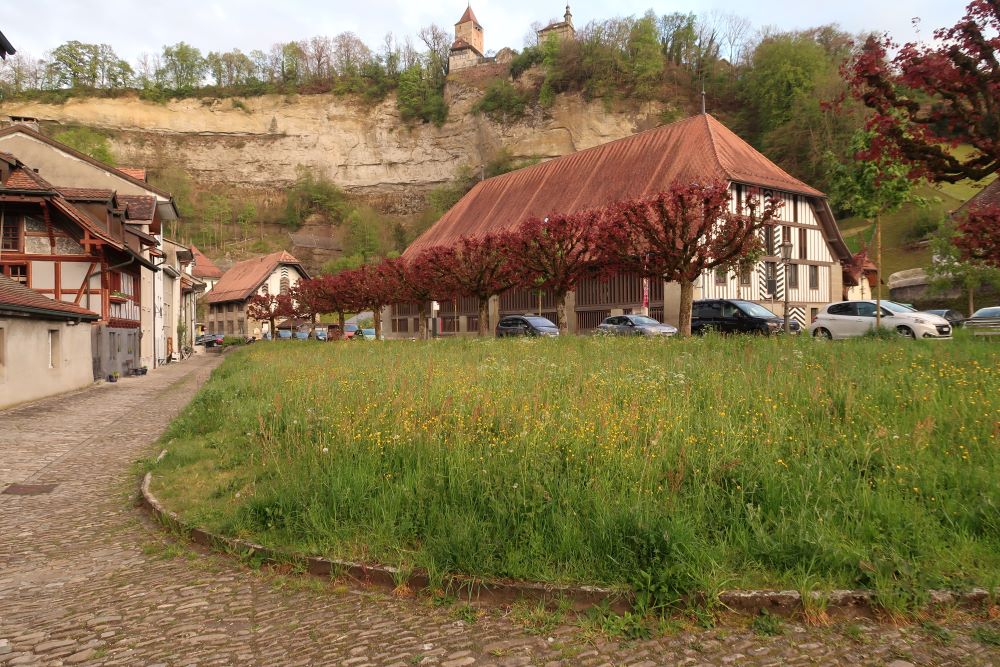Fribourg or Freiburg, la Sarine or die Saane, French- or German-speaking, the city is (or was) loyal to the Catholic faith during and after the Reformation in the first half of the 16th century. However, the diversity of monastic orders and abbeys is (or was) all the more significant.

La Sarine or die Saane, the so-called Röstigraben
The Gothic cathedral, dedicated to St Nicholas, was completed in 1490 after a two-century construction period. The city also has an icon. Today, the city is the seat of the diocese of Lausanne, Geneva, Neuchâtel, and Fribourg.

The city was founded in 1157 by the German-speaking Duke Bertold IV of Zähringen (1125-1186) in the predominantly French-speaking area of the former kingdom of Burgundy (888-1032).
His successor founded the city of Bern in 1191. The counts of Kyburg acquired Zähringen in 1218. In 1277, the town came into the hands of the Habsburgs, who ruled until 1452.
The city became embroiled in the wars between Habsburg and the Duchy of Savoy and sided with Savoy from 1452 to 1477. However, Savoie was also an ally of the Duke of Burgundy.
After Duke Charles the Bold’s three defeats against the Swiss Eidgenossenschaft in 1476 (Grandson and Murten) and 1477 (Nancy), the city joined the Eidgenossenschaft in 1481 after having significantly expanded its territory at the expense of Savoie.


The Rote Turm

The city wall, 13th century
Despite the Reformation in Bern, the Catholic city of Fribourg allied with Bern and conquered and split Vaud in 1536. Fribourg acquired Gruyère in 1555, reaching its present size.
After 1530, the city was a bastion of the Counter-Reformation and Jesuit influence, culminating in the Sonderbund and its lost war in 1847.

The former Jesuit college Saint-Michel
The largest existing abbeys are Notre-Dame de la Maigrauge (a Cistercian monastery for women, founded in the 13th century, the Montorge Abbey (Franciscan monastery for monks, founded in 1621) the Abbey d’Hauterive (a Cistercian monastery for monks, founded in 1138), the Capuchin monastery (founded in 1617), the Franciscan-Minorites (or Couvent de Cordeliers, founded in 1256) and several smaller orders. The Jesuits and Augustinians have not been represented in the city since 1848 (after the lost Sonderbunds War). The Dominicans are still present, but mainly as an institution of theology.

An almost forgotten history is Freiburg’s port. In the old town lies an area that has been a storage and trading place for shipping for centuries. Numerous buildings highlight this past.

As with any larger city in Switzerland (Zurich is the largest, with 400,000 inhabitants; Fribourg has only 80,000), nature is always close. Cattle also enjoy the view of St Nicolas Cathedral every day. Where in the world is that (still) possible?
(Bron en verdere informatie: Ville de Fribourg)
La Sarine of die Saane




The Dam near Notre-Dame de la Maigrauge

The former Augustiner Order and Kirche






The former Johanniter Order and garden (now a restaurant)
The cathedral and the Liebfrauen Kirche

In the background, the snow-covered summit of Le Chasseral (canton of Bern)




The Liebfrauenkirche
Monasteries

Franciscan Monastery


The Abbey of Montorge












The Abbey of Hauterive


Porte de la Maigrauge/Sonnenbergtor






The Abbey Notre-Dame de la Maigrauge
The Bridges



Pont du Gottéron

Pont de la Madeleine


The Viaduc de Grandfey , the railway Bern-Fribourg-Lausanne, 1862


Pont de la Poya

Pont de Zaehringen/Zähringenbrücke
Die St. Johannbrücke (le pont de Saint-Jean), die Mittlere Brücke (le pont du Milieu), and die Bernbrücke (le pont de Berne) are the three oldest bridges in the city (all dating back to the 13th century).
They were originally made of wood, but in the 18th century, the St. Johannbrücke/ pont de Saint-Jean and the Mittlere Brücke/pont du Milieu were rebuilt in stone. Only the Bernbrücke/ pont de Berne remained wooden for strategic reasons. In the event of attacks from the east, the people of Fribourg removed the bridge’s planks to keep the invaders on the other side of the Saane/Sarine.




Bernbrücke/ pont de Berne


Mittlere Brücke/pont du Milieu


St. Johannbrücke/ pont de Saint-Jean
Bourguillon Castle and the Lorette Chapel





The heraldy of Habsburg



The Lorette Chapel

The chapel St. Jost (1684), belonging to the monastery of Montorge
The old town and port








Impressions of the city

The funiculaire (1899)


The Museum of Art and History (Musée d’art et d’histoire)




The city hall (Hôtel de Ville). The Eternal Peace Treaty (la Paix perpétuelle) with France was signed in this building in 1516 after the defeat at Marignano (1515)





Espace Jean Tinguely and Niki de Saint Phalle
The Surroundings















The ancient mill in Richterswil



















































